Bringing a dog into your home is an exciting prospect, promising companionship, joy, and unconditional love. However, for many individuals, the dream of pet parenthood is often clouded by the reality of allergies. Dog allergies, triggered by proteins found in a dog’s dander (dead skin cells), saliva, and urine, can cause uncomfortable symptoms ranging from sneezing and itching to more severe respiratory issues. This challenge has led to a significant interest in “hypoallergenic” dogs, or more accurately, most popular dog breeds that don’t shed much, as they are often perceived as a solution for allergy sufferers.
While it’s crucial to understand that no dog is 100% allergen-free, breeds that shed minimally produce less dander and thus fewer airborne allergens. This characteristic makes them a much better fit for people with sensitivities, allowing them to experience the unique bond with a canine companion without constant discomfort. This guide will delve into these wonderful breeds, offering insights into their traits, care requirements, and what makes them popular choices for those seeking a low-shedding friend. We’ll also provide practical tips for successfully living with these delightful dogs to ensure a happy, healthy, and sneeze-free home. For those looking for intelligent small companions that fit this description, explore smartest small dogs that don t shed.
Understanding Low-Shedding vs. Hypoallergenic
The terms “hypoallergenic dog” and “low-shedding dog” are often used interchangeably, but there’s a subtle yet important distinction. A dog labeled “hypoallergenic” is generally understood to produce fewer allergens. However, as noted by the National Institute of Environmental Health Sciences, all dogs produce allergens in their dander, saliva, and urine. The key factor is shedding. Dogs that shed less also distribute fewer allergen-laden hairs and dander into their environment. This reduction in airborne allergens is what makes them more tolerable for many allergy sufferers.
Therefore, when we talk about most popular dog breeds that don’t shed, we’re primarily referring to breeds with hair-like coats that grow continuously (similar to human hair) rather than fur that goes through seasonal cycles of shedding. This type of coat traps dander and loose hairs, releasing less into the home. Regular grooming, including brushing and bathing, is then essential to remove these trapped allergens and maintain a clean environment.
Factors Contributing to Dog Allergies
Dog allergies are typically caused by specific proteins, primarily found in dander, but also present in a dog’s saliva and urine. When a dog sheds, these tiny flakes of skin, along with dried saliva and urine particles, become airborne. For individuals with sensitive immune systems, exposure to these proteins can trigger an allergic reaction. Symptoms can vary widely, from mild sneezing, runny nose, and itchy eyes to more severe issues like asthma attacks, skin rashes, and difficulty breathing. Even hairless dogs can trigger allergies because they still produce saliva and dander on their skin, though they may distribute fewer airborne allergens simply because there’s less hair to carry them.
Top Popular Dog Breeds That Don’t Shed
Here are some of the most popular dog breeds that don’t shed much, making them excellent choices for many households, especially those with allergy concerns.
1. Poodle
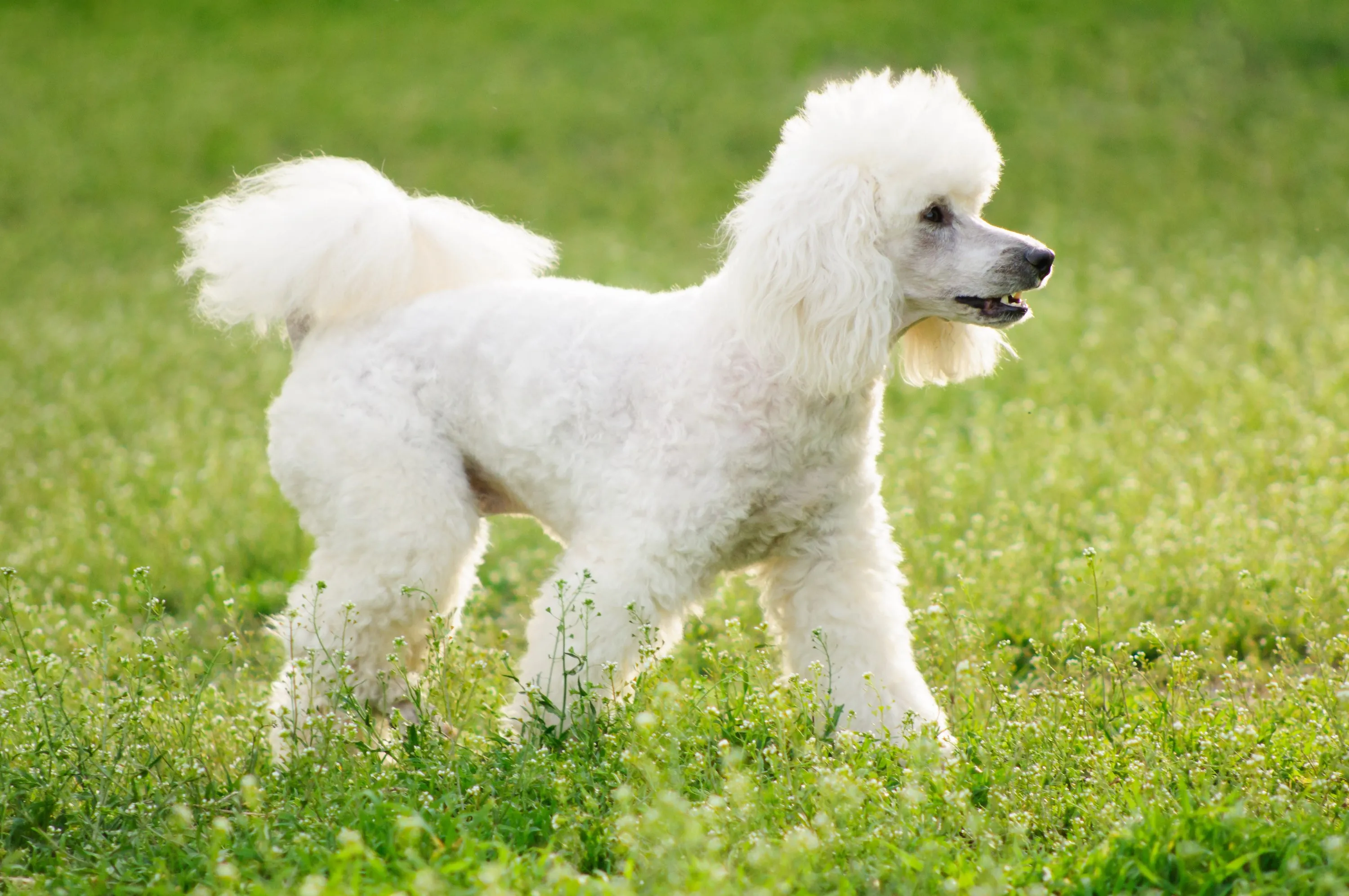 Graceful white Poodle with curly, low-shedding coat walking in a sunny grassy field
Graceful white Poodle with curly, low-shedding coat walking in a sunny grassy field
Poodles are perhaps the quintessential example of a low-shedding breed, renowned for their intelligence and distinctive curly coats. There are three sizes: Standard, Miniature, and Toy Poodle. The Standard Poodle, originally bred as a water retriever, is the largest, while Miniature and Toy Poodles were selectively bred for smaller sizes. Regardless of size, Poodles possess a luxurious, dense coat that sheds minimally, making them a top choice for allergy sufferers. Their high intelligence makes them highly trainable and versatile, excelling in various dog sports and roles. However, their non-shedding coat requires consistent grooming, including regular brushing to prevent matting and professional clipping every 4-6 weeks to keep their curls in top condition.
2. Yorkshire Terrier
 Blue and tan Yorkie lounging comfortably on an armchair in a cozy home
Blue and tan Yorkie lounging comfortably on an armchair in a cozy home
These spirited little dogs, often called “Yorkies,” are beloved for their bold personalities, silky, hair-like coats, and affectionate nature. Their fine, non-shedding hair is similar to human hair, meaning it grows continuously and doesn’t shed like typical fur. This makes them one of the smallest dog breeds that doesn’t shed, fitting perfectly into various living situations, from bustling city apartments to larger homes, as long as they receive ample attention and companionship from their families. Yorkies require daily brushing to prevent tangles and regular trims to maintain their coat’s length and health.
3. Shih Tzu
 Friendly brown and white Shih Tzu resting on a living room floor
Friendly brown and white Shih Tzu resting on a living room floor
Originating from Tibetan nobility, the Shih Tzu is an ancient companion breed celebrated for its charming demeanor and long, flowing coat that sheds very little. They are known for their friendly and outgoing temperament, making them wonderful small lap dogs that don’t shed and ideal family pets. However, their distinctive flat faces can predispose them to certain health issues, such as overheating and breathing difficulties, especially in warm weather. Their luxurious double coat demands daily brushing and regular professional grooming to prevent matting and keep them comfortable. Specific care, like eye cleaning wipes, can help manage tear stains, a common issue for the breed.
4. Miniature Schnauzer
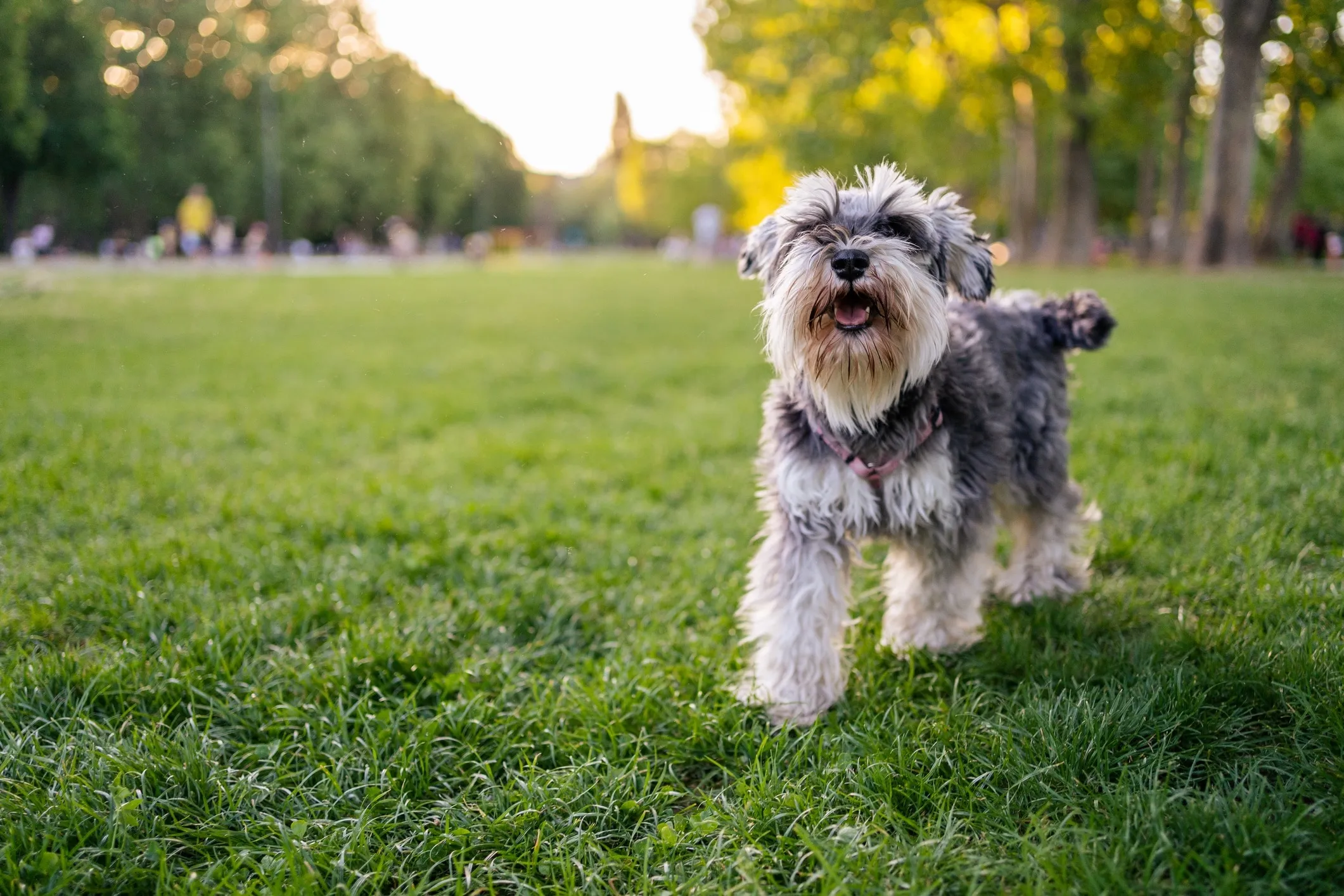 Alert salt and pepper Miniature Schnauzer wearing a pink harness in a park
Alert salt and pepper Miniature Schnauzer wearing a pink harness in a park
The Miniature Schnauzer is a robust and intelligent dog, known for its distinctive bushy eyebrows and beard. As one of three Schnauzer varieties, the Miniature is the smallest, typically weighing between 10-20 pounds and standing up to 14 inches tall. Their wiry topcoat and soft undercoat shed minimally, making them a popular choice among dog breeds that don’t shed. Miniature Schnauzers are adaptable and can thrive in various home environments, provided they receive at least an hour of daily exercise and mental stimulation to satisfy their active minds. Regular grooming, including hand-stripping or clipping, is necessary to maintain their coat texture and characteristic appearance.
5. Standard Schnauzer
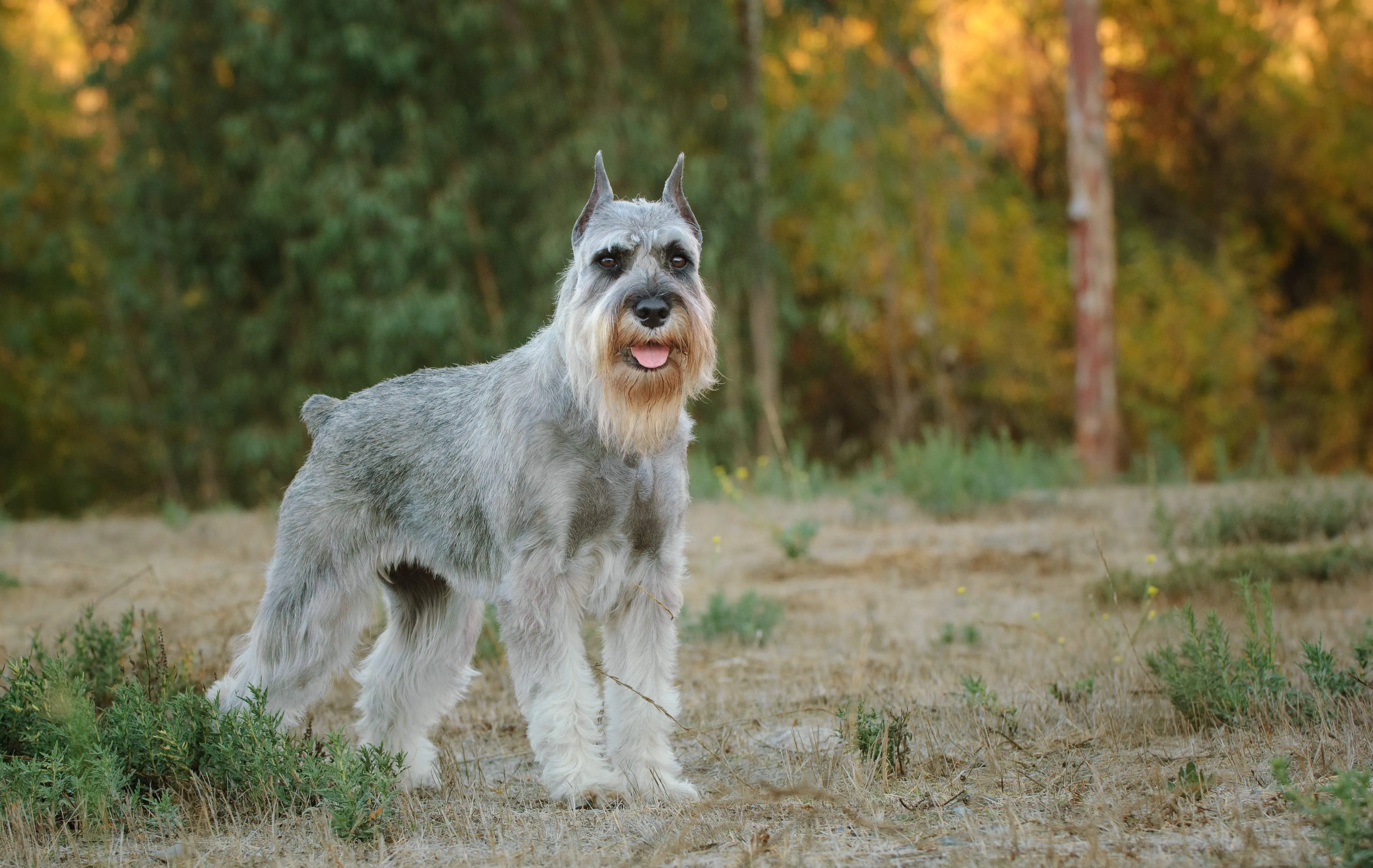 Majestic gray Standard Schnauzer standing attentively in a green field
Majestic gray Standard Schnauzer standing attentively in a green field
Sharing many of the appealing qualities of their miniature counterparts, Standard Schnauzers offer a slightly larger, more substantial presence, often weighing up to 45 pounds. They retain the same low-shedding, wiry coat and keen intelligence. These dogs thrive on activity and mental engagement, making them excellent companions for active individuals or families. Daily long walks, engaging games of fetch, and interactive puzzle toys are essential to keep a Standard Schnauzer happy and well-behaved. Their robust nature and minimal shedding contribute to their popularity as a medium and large dog that doesn’t shed.
6. Giant Schnauzer
 Powerful black wet Giant Schnauzer wearing a blue bow collar standing in a park
Powerful black wet Giant Schnauzer wearing a blue bow collar standing in a park
As the largest of the Schnauzer breeds, Giant Schnauzers can reach over 27 inches tall and weigh up to 85 pounds. Despite their imposing size, they are part of the family of dog breeds that don’t shed, thanks to their dense, wiry coats. These powerful dogs possess immense energy and intelligence, requiring substantial daily exercise to remain content and prevent destructive behaviors. Activities such as extended walks, runs, hikes, and vigorous games of fetch are crucial for their physical and mental well-being. Their protective yet loyal nature makes them great companions for experienced dog owners who can meet their needs.
7. Bichon Frise
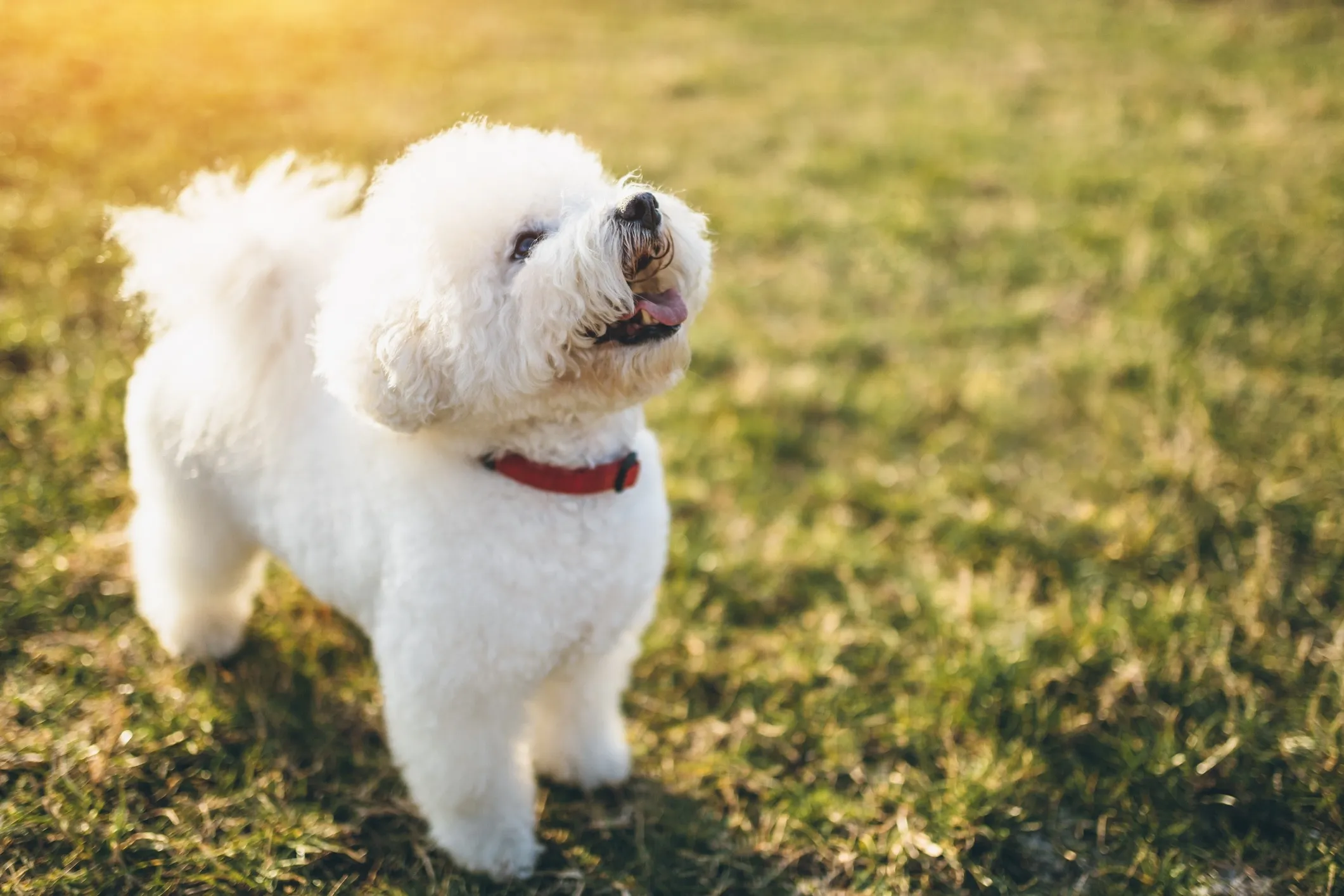 Small white Bichon Frise with curly hypoallergenic coat looking up in lush green grass
Small white Bichon Frise with curly hypoallergenic coat looking up in lush green grass
The Bichon Frise is a cheerful, affectionate, and playful small dog with a distinctive curly, powder-puff coat that sheds very little. Their compact size and adaptable nature make them ideal for various living situations, including apartments. Bichons are highly intelligent and eager to please, responding well to positive reinforcement training methods and quickly learning basic commands and fun tricks. Regular grooming is vital for a Bichon Frise, including daily brushing to prevent matting of their dense double coat and professional grooming every 4-6 weeks to maintain their iconic fluffy appearance. They make wonderful small lap dogs that don’t shed and are often considered good family dogs.
8. Chinese Crested
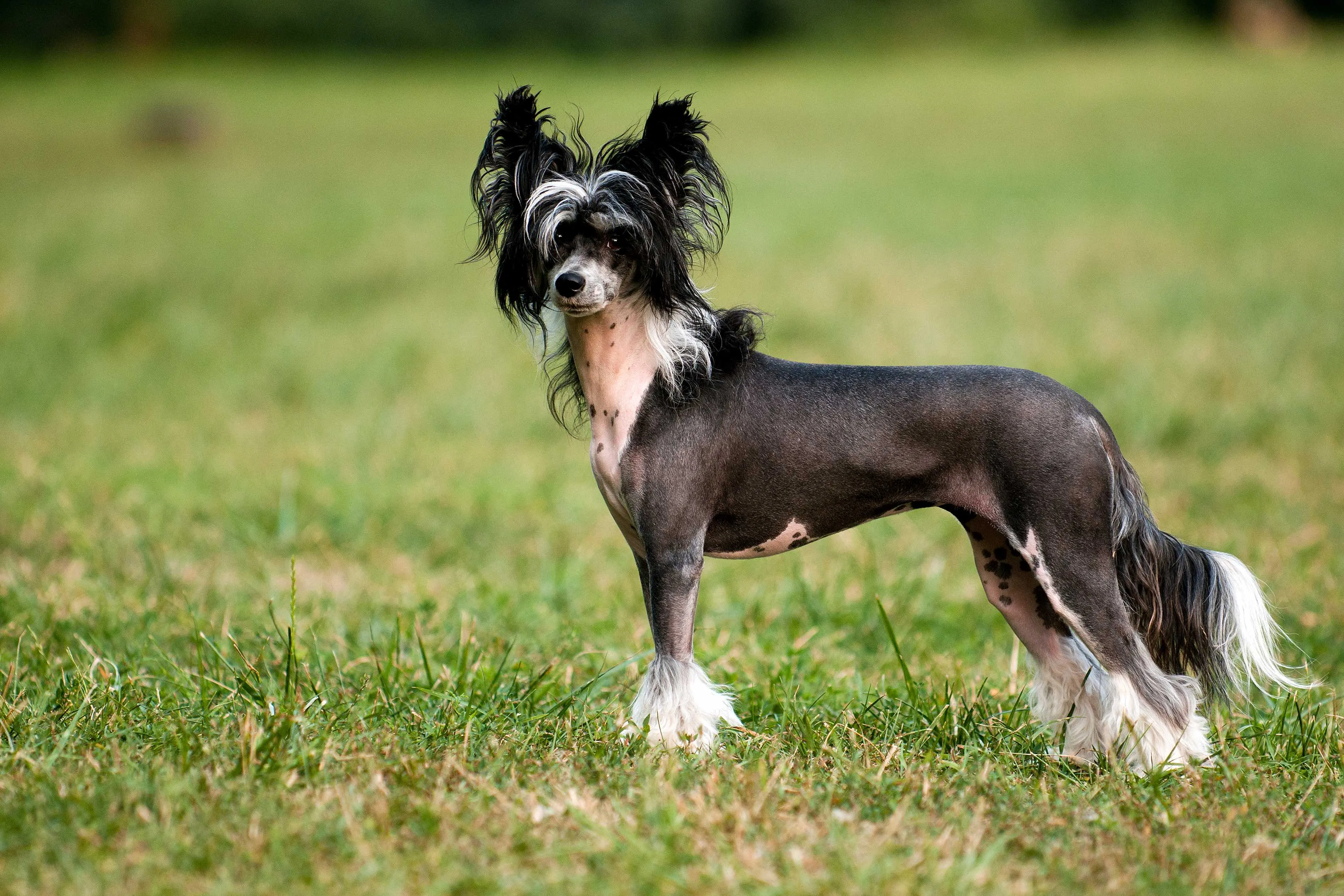 Unique black hairless Chinese Crested dog looking at the camera
Unique black hairless Chinese Crested dog looking at the camera
The Chinese Crested is a truly unique breed, known for its distinctive appearance and low-shedding qualities. It comes in two varieties: the Hairless, with smooth skin and tufts of hair on its head, tail, and paws, and the Powderpuff, covered in a full, soft, silky coat. Both varieties are considered dog breeds that don’t shed much and are a good fit for allergy sufferers. Playful, affectionate, and gentle, Chinese Cresteds are devoted companions. The Hairless variety requires skin care to protect from sun and cold, while the Powderpuff needs regular brushing to prevent matting. For more options in this size category, consider checking out other smallest dog breed that doesn t shed.
9. Portuguese Water Dog
 Energetic black and white Portuguese Water Dog wearing a red maple leaf bandana in front of water
Energetic black and white Portuguese Water Dog wearing a red maple leaf bandana in front of water
Originally bred to assist fishermen in Portugal, the Portuguese Water Dog is a robust, intelligent, and highly energetic medium and large dog that doesn’t shed. Their thick, curly, waterproof coat is well-suited for aquatic environments and sheds very little, making them a favorite among active families and those with allergies. These dogs are highly trainable and friendly, thriving on regular, vigorous exercise like swimming, long walks, and mentally stimulating games. Their love for water means they are always up for a game of fetch with floating toys, which is an excellent way to burn off their abundant energy and keep them healthy.
10. Labradoodle
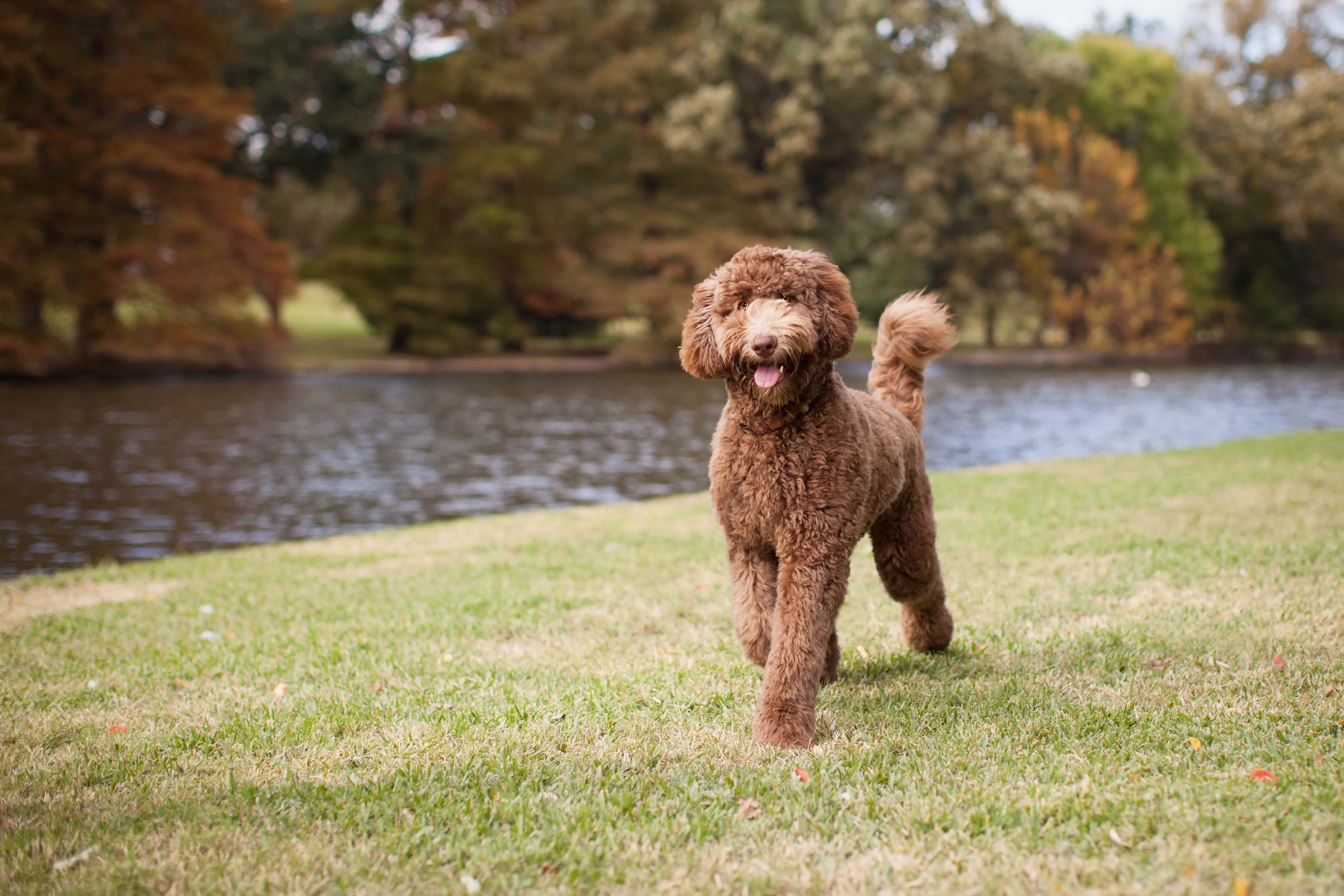 Friendly brown standard Labradoodle walking in a park
Friendly brown standard Labradoodle walking in a park
A crossbreed resulting from a Labrador Retriever and a Poodle, the Labradoodle was originally developed with the intention of creating a low-shedding service dog. They inherit the intelligence and friendly nature of both parent breeds, making them excellent family pets. Their coat types can vary, but many possess the desirable low-shedding qualities of the Poodle, contributing to their popularity. Labradoodles are highly trainable and generally gentle, especially when properly exercised and socialized from an early age. They are often cited as good family dogs that don’t shed much due to their balanced temperament and minimal shedding.
11. Goldendoodle
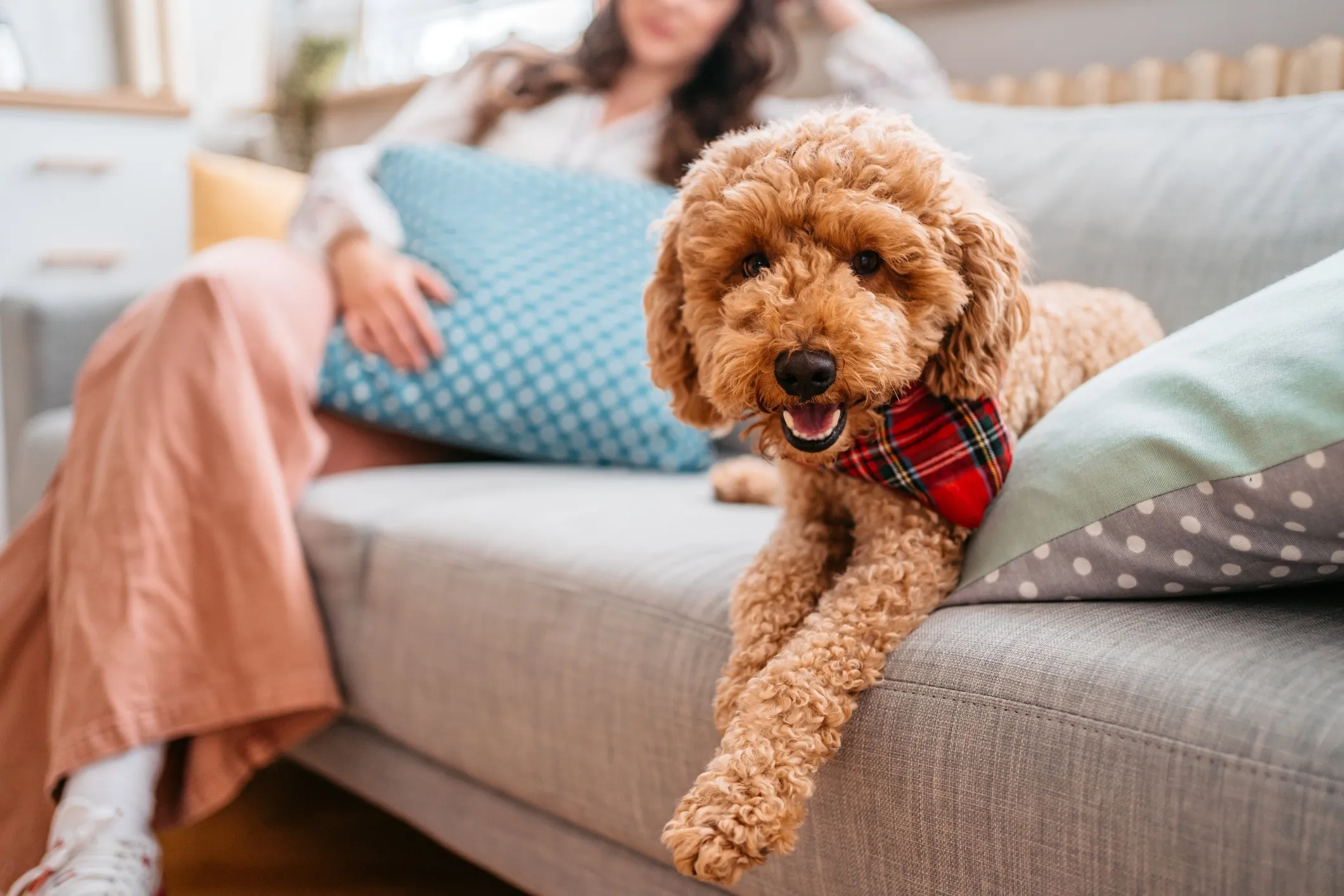 Gentle Goldendoodle lying on a couch with a person sitting in the background
Gentle Goldendoodle lying on a couch with a person sitting in the background
Another beloved “doodle” breed, Goldendoodles are a cross between a Golden Retriever and a Poodle. Like Labradoodles, they are highly intelligent, possess a friendly nature, and shed minimally, making them ideal for allergy sufferers. While often known for their beautiful golden coats, they can come in a variety of colors and textures. Their luscious, curly or wavy coats require frequent grooming with a slicker brush to prevent matting and maintain their soft texture. Goldendoodles thrive on companionship and activity, making them excellent, adaptable family pets.
12. Lagotto Romagnolo
 Two expressive Lagotto Romagnolo dogs lying in dirt staring intently at the camera
Two expressive Lagotto Romagnolo dogs lying in dirt staring intently at the camera
The Lagotto Romagnolo, an ancient Italian breed, was originally bred as a water retriever and truffle hunter. Their curly, woolly coat is dense and waterproof, providing protection from cold waters while shedding very little. Though less common than some other low-shedding breeds, Lagotti Romagnoli are known for being affectionate and intelligent, often getting along well with children and other pets, making them good family dogs. Their unique coat requires specific grooming to prevent felting and keep it healthy.
13. Affenpinscher
 Close-up of a mischievous black Affenpinscher dog with a monkey-like expression
Close-up of a mischievous black Affenpinscher dog with a monkey-like expression
These small, distinctive dogs are nicknamed “monkey terriers” due to their expressive, monkey-like faces. Affenpinschers possess a dense, wiry coat that produces fewer allergens compared to many other breeds, making them a suitable choice for some allergy sufferers. Their low-shedding coat requires regular care, including at-home brushing and occasional hand-stripping by a professional groomer to maintain its texture and minimize shedding. Despite their small size, Affenpinschers have big personalities – they are curious, playful, and fiercely loyal to their families.
14. Irish Water Spaniel
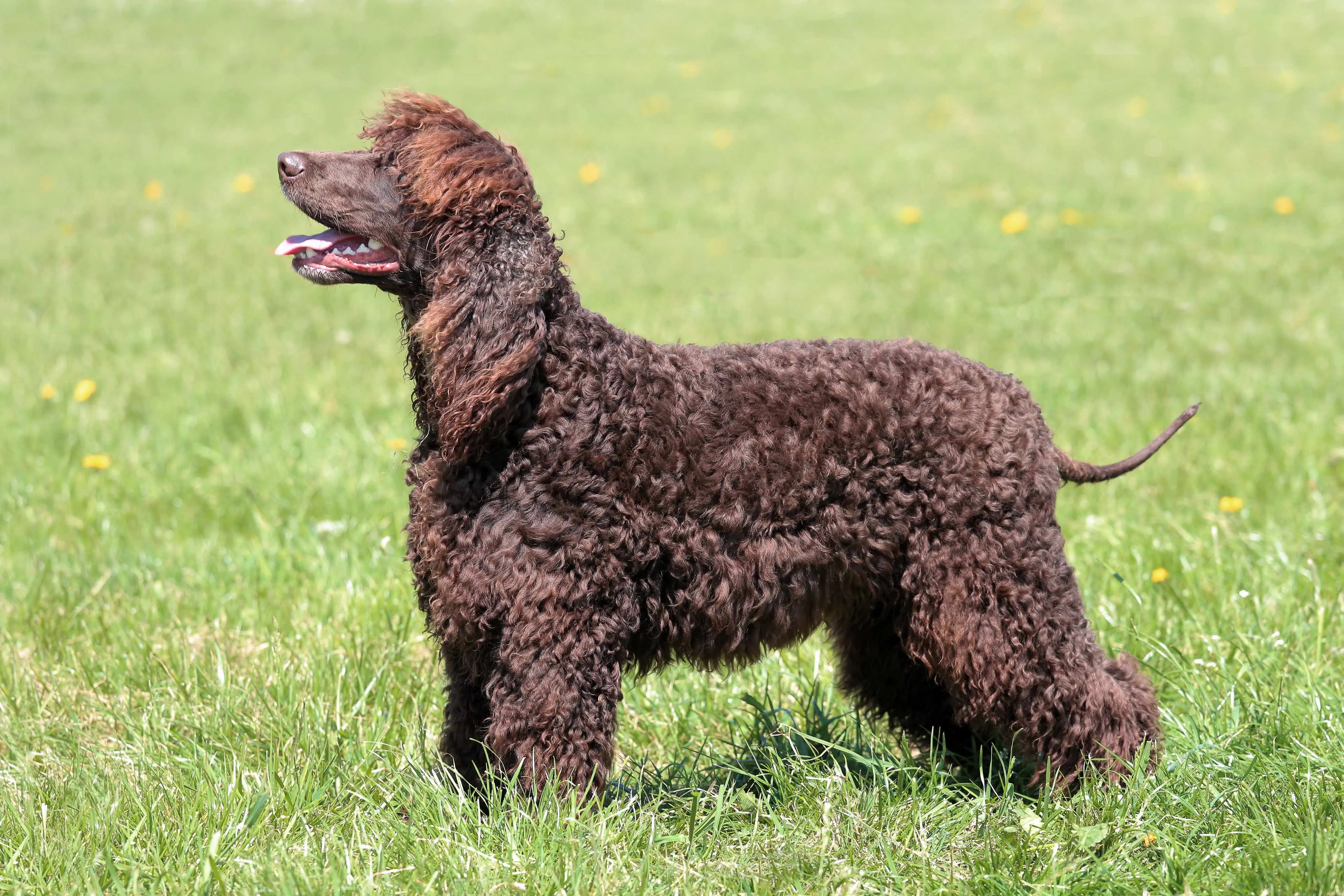 Profile view of a friendly brown Irish Water Spaniel with a distinct topknot
Profile view of a friendly brown Irish Water Spaniel with a distinct topknot
The Irish Water Spaniel is a distinguished water dog breed, historically used for retrieving game. They are characterized by their thick, curly, liver-colored coat and a “rat tail.” This unique coat sheds minimally, but requires regular grooming to prevent matting. Friendly, intelligent, and highly trainable, Irish Water Spaniels possess a high energy level and require substantial exercise to stay happy and healthy. Their robust nature and enthusiasm for activity make them excellent companions for active individuals or families who can meet their exercise needs.
15. Aussiedoodle
 Majestic standard Aussiedoodle dog standing on a beach with ocean in the background
Majestic standard Aussiedoodle dog standing on a beach with ocean in the background
A cross between an Australian Shepherd and a Standard or Miniature Poodle, the Aussiedoodle is a highly intelligent and energetic dog, inheriting desirable traits from both parent breeds. Many Aussiedoodles inherit the Poodle’s low-shedding coat, making them a popular choice for those seeking a dog that doesn’t shed. However, their high intelligence and energy mean they require significant exercise and mental stimulation, often through enrichment toys like treat dispensers, to prevent boredom and destructive behaviors. Early training and socialization are also crucial for this dynamic breed.
16. Bolognese
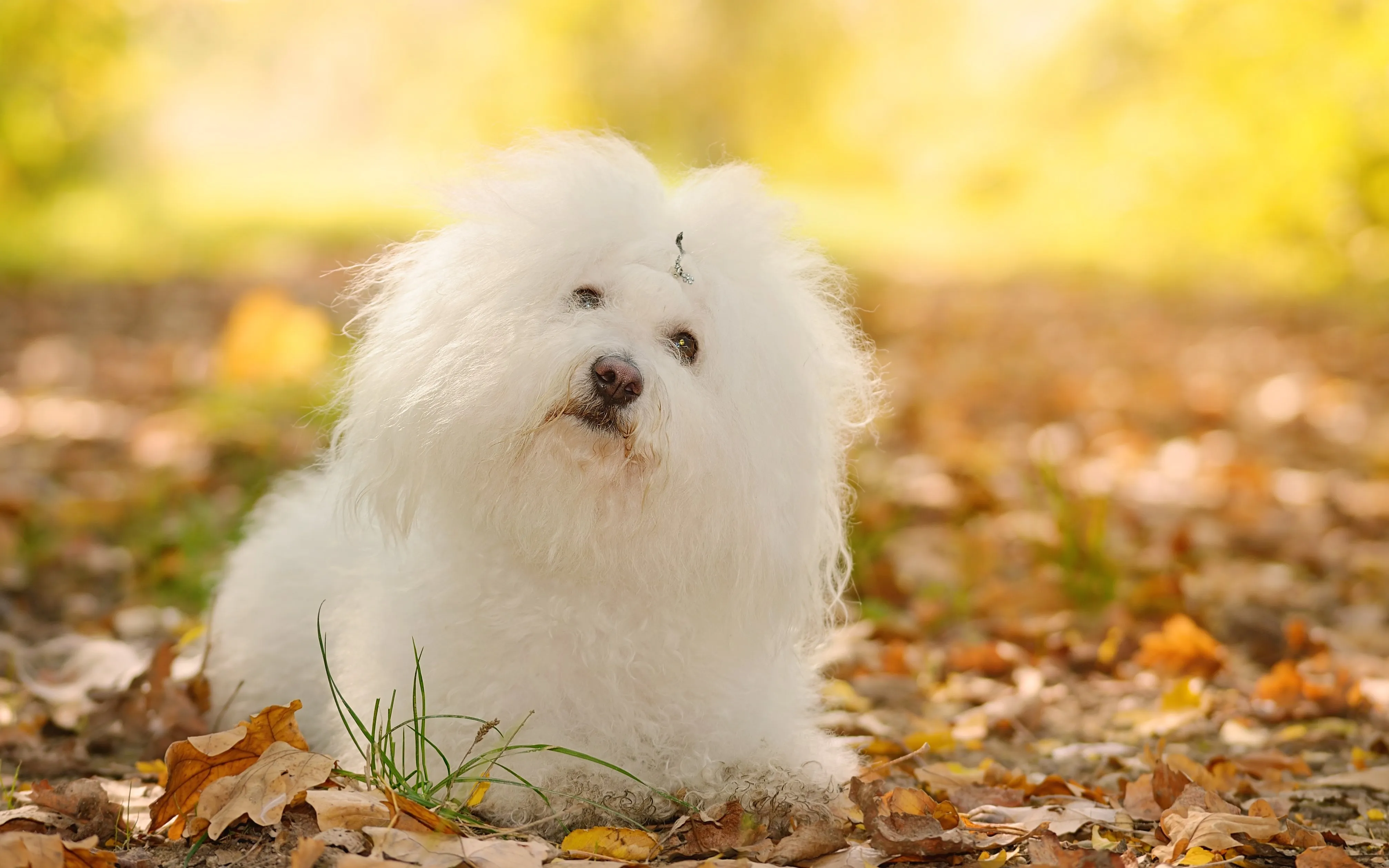 Fluffy white Bolognese dog sitting in an autumn forest, looking content
Fluffy white Bolognese dog sitting in an autumn forest, looking content
Hailing from Italy, the Bolognese is a charming and cute small dog known for its long, fluffy white coat, which, despite its characteristic “messy” appearance, sheds minimally. These playful and easygoing pups are typically good with children and other pets, and their adaptable nature allows them to thrive in various living situations. However, their beautiful coats demand consistent grooming, including daily brushing to prevent matting and regular trips to the groomer. Their devotion to their families makes them excellent small lap dogs that don’t shed.
17. Maltese
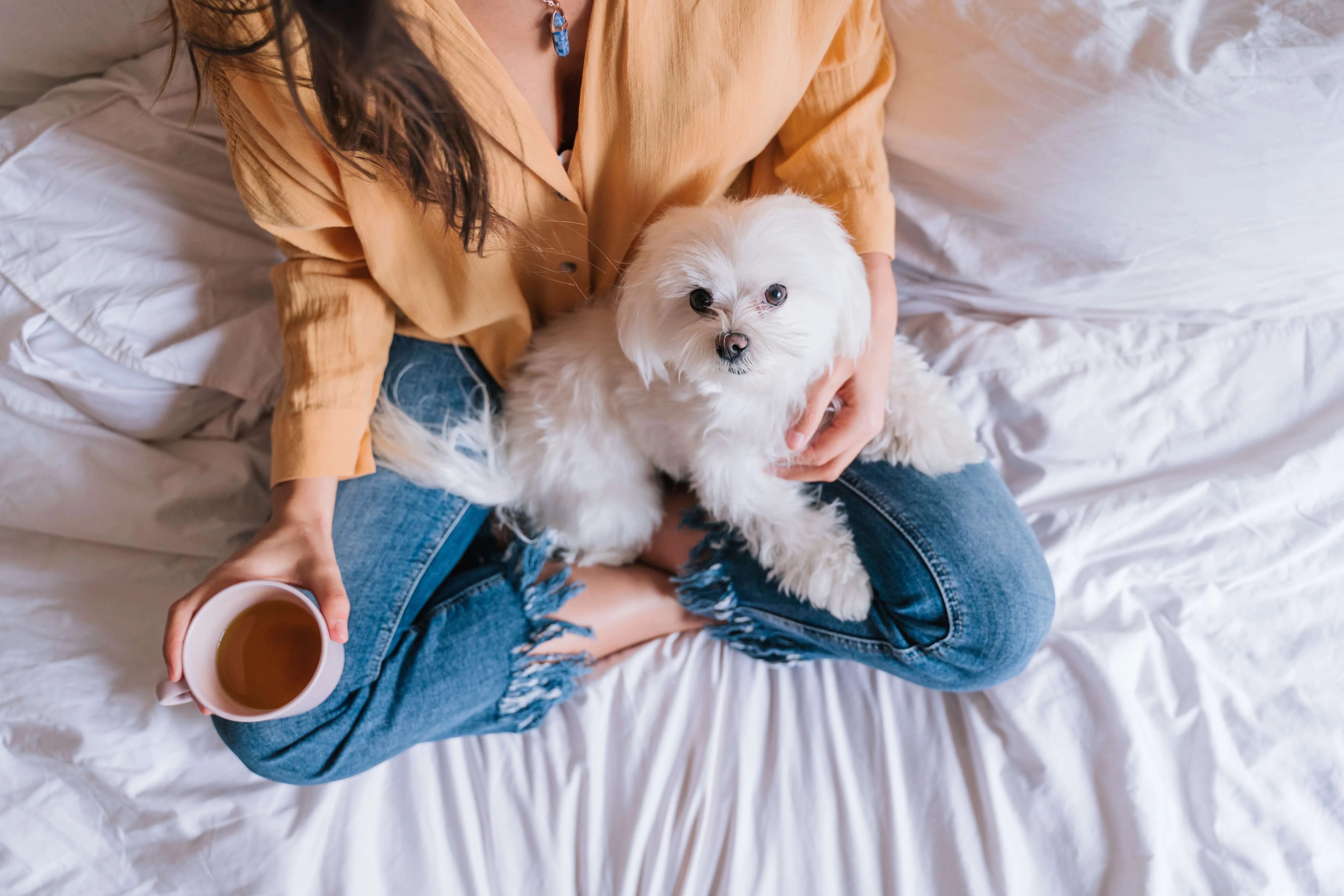 Elegant woman gently holding a white Maltese dog on a bed
Elegant woman gently holding a white Maltese dog on a bed
The Maltese is a small, aristocratic breed famed for its luxurious, long, silky white coat that sheds very little. They are affectionate, playful, and charming companions, forming strong bonds with their human families. While their long coat is stunning, it requires dedicated grooming to prevent tangles and matting. Many Maltese owners opt for a shorter “puppy cut” to make grooming more manageable, which can be achieved with dog hair grooming clippers. Their minimal shedding and endearing personalities solidify their status as a beloved smallest dog breed that doesn’t shed.
18. Soft Coated Wheaten Terrier
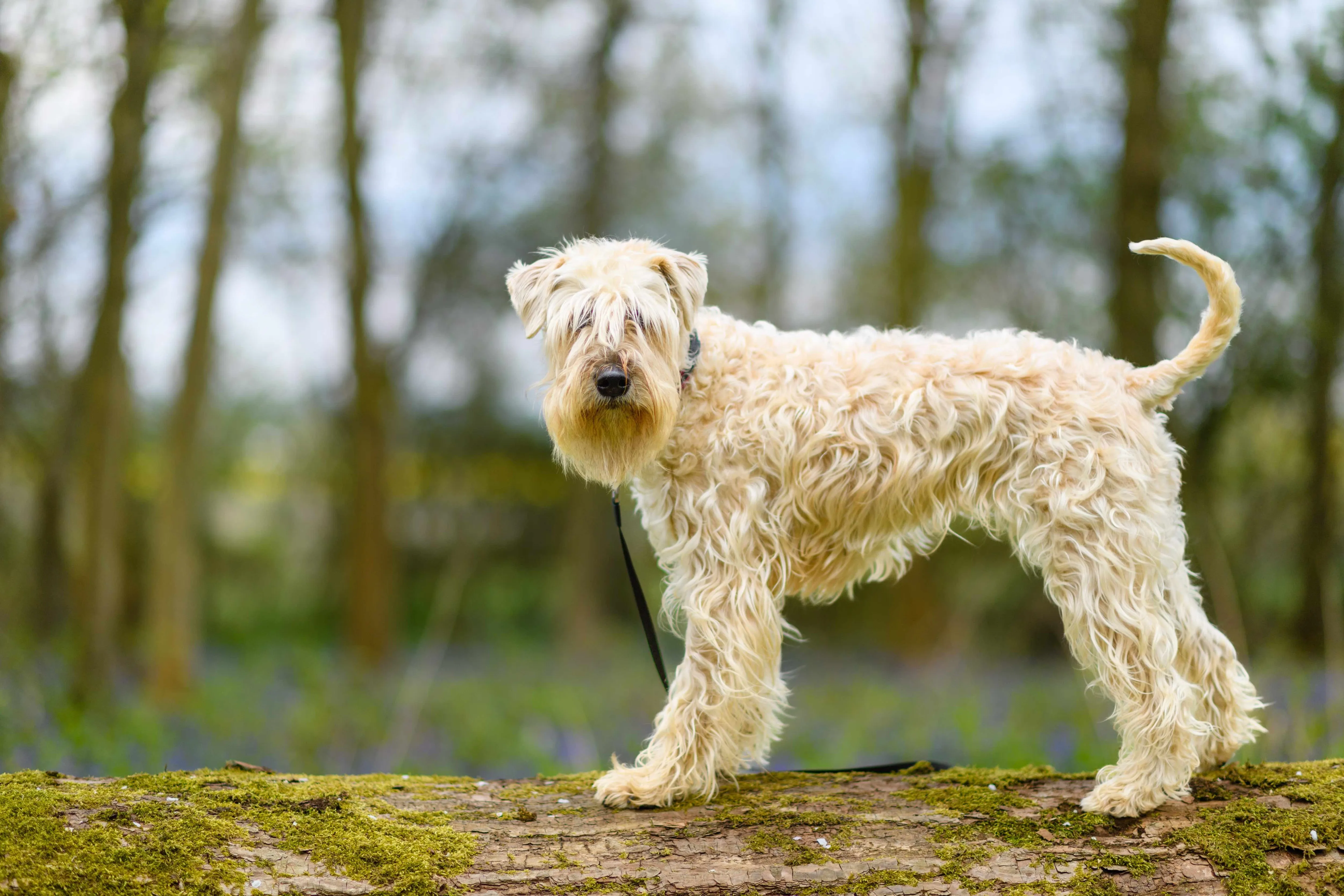 Joyful Soft Coated Wheaten Terrier dog playing on a log
Joyful Soft Coated Wheaten Terrier dog playing on a log
This medium-sized Irish breed is named for its incredibly soft, silky coat that feels like wheat and sheds minimally. Wheatens are known for their lively and exuberant personalities, often greeting people with their characteristic “Wheaten Greetin'” – a joyful leap. As terriers, they maintain a high energy level throughout their lives and require ample daily exercise and mental stimulation to keep them happy and well-behaved. Regular brushing is essential to prevent their soft coats from matting, making them a popular choice among medium and large dogs that don’t shed for active families.
19. Coton de Tulear
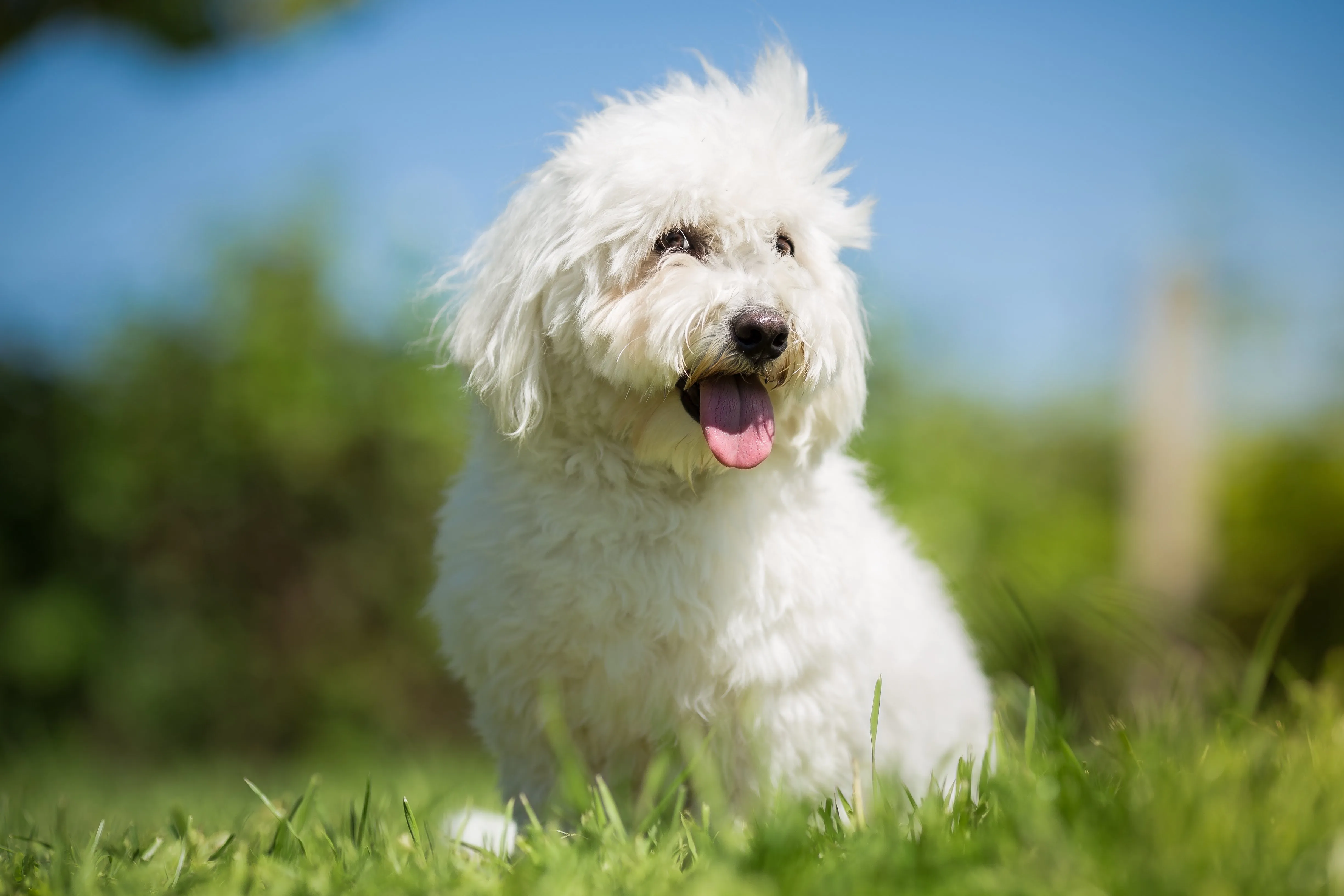 Fluffy white Coton de Tulear sitting in grass with its hair gently blowing in the wind
Fluffy white Coton de Tulear sitting in grass with its hair gently blowing in the wind
Originating from Madagascar, the Coton de Tulear is a small, charming breed known for its soft, cotton-like coat that sheds minimally. These easygoing and affectionate pups are well-suited for families with children and other pets, especially when proper introductions are made. Their friendly nature and adaptability make them wonderful companions for various living situations. The Coton’s unique coat requires regular grooming, including daily brushing, to prevent tangles and maintain its distinctive texture.
20. Schnoodle
 Close-up of an alert gray Schnoodle with a curly coat
Close-up of an alert gray Schnoodle with a curly coat
The Schnoodle is a designer breed that combines two low-shedding breeds: the Schnauzer and the Poodle. This combination often results in a dog with a low-shedding coat that can be curly or wavy, depending on the genes inherited from its parents. Schnoodles are intelligent, playful, and affectionate, making them great family pets. Their adaptable nature means they can thrive in various environments, from apartments to larger homes, as long as their moderate exercise and grooming needs are met. Regular brushing is crucial to prevent matting of their diverse coat types.
21. Bedlington Terrier
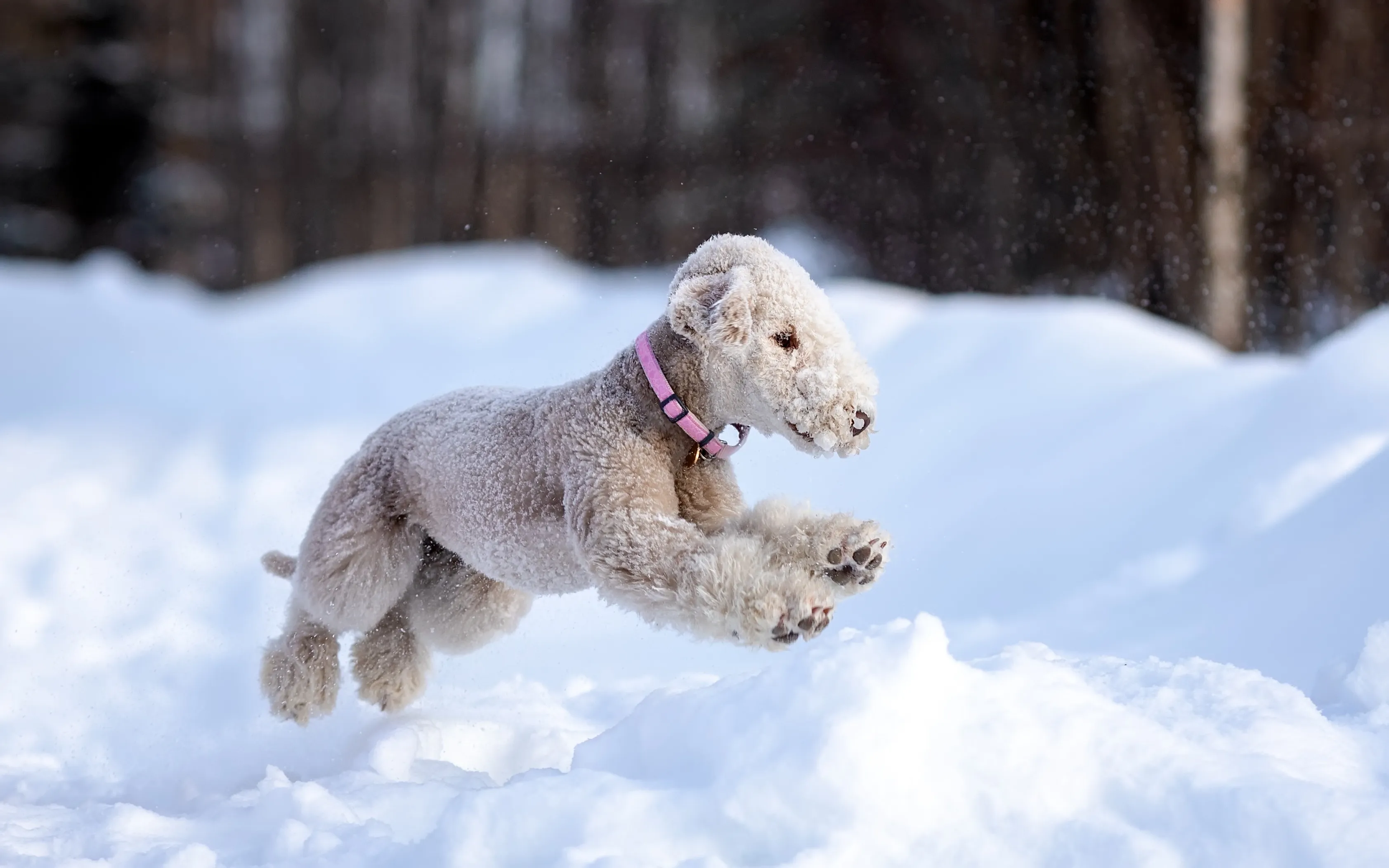 Agile white Bedlington Terrier gracefully running through fresh snow
Agile white Bedlington Terrier gracefully running through fresh snow
Often described as “a lamb in dog’s clothing,” the Bedlington Terrier is a small, distinctive breed recognized by its curly, woolly coat, arched back, and unique topknot and ear tufts. Their minimal-shedding coat makes them a suitable choice for allergy sufferers. Bedlingtons are known for being devoted and loving companions who thrive on being close to their people. They can be prone to separation anxiety if left alone for extended periods. Monitoring their activity with a dog camera can help detect and address such behavioral issues. Despite their gentle appearance, they are lively and require regular exercise and mental engagement.
22. Xoloitzcuintli
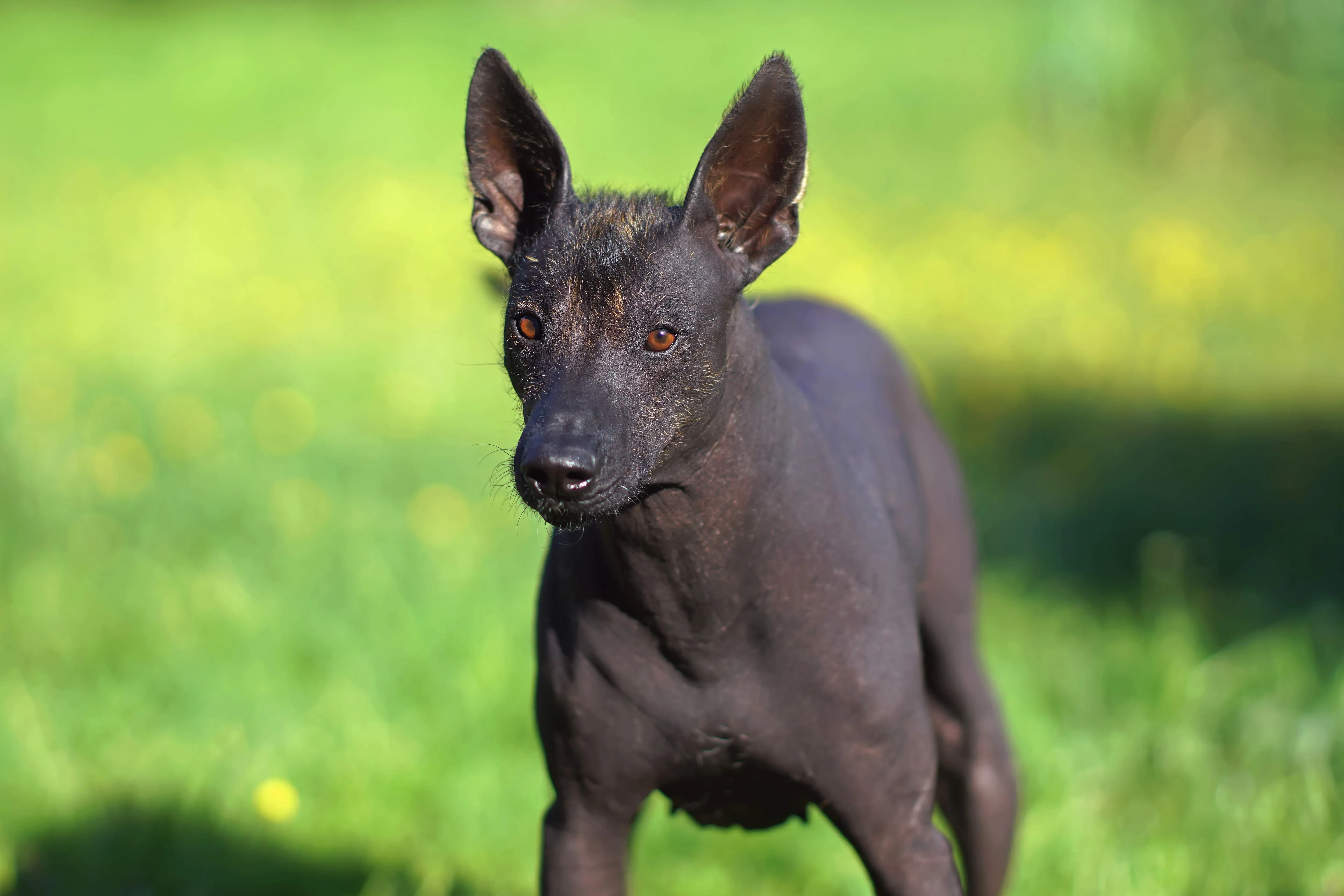 Majestic black Mexican Hairless Dog (Xoloitzcuintli) standing elegantly in green grass
Majestic black Mexican Hairless Dog (Xoloitzcuintli) standing elegantly in green grass
Also known as the Mexican Hairless Dog, the Xoloitzcuintli is one of the oldest and rarest dog breeds. They come in three sizes (toy, miniature, and standard) and two coat varieties: hairless and coated (with a very short, smooth coat). Both varieties are considered low-shedding and are suitable for those with allergies. Xolos are calm, loyal, and intelligent dogs, forming strong bonds with their families. The hairless variety requires special skin care, including moisturizing and sun protection, while the coated variety needs minimal grooming.
23. Whoodle
 Playful tan Whoodle puppy happily dragging a washcloth
Playful tan Whoodle puppy happily dragging a washcloth
A delightful cross between a Soft-Coated Wheaten Terrier and a Poodle, the Whoodle is a friendly and affectionate dog that sheds very little. They inherit the intelligence and charming nature from both parent breeds, resulting in a lively and devoted companion. Whoodles typically have a soft, wavy, or curly coat that requires regular brushing to prevent matting. They are energetic and enjoy playtime, making them a great fit for active families who can provide consistent exercise and mental stimulation.
24. Bernedoodle
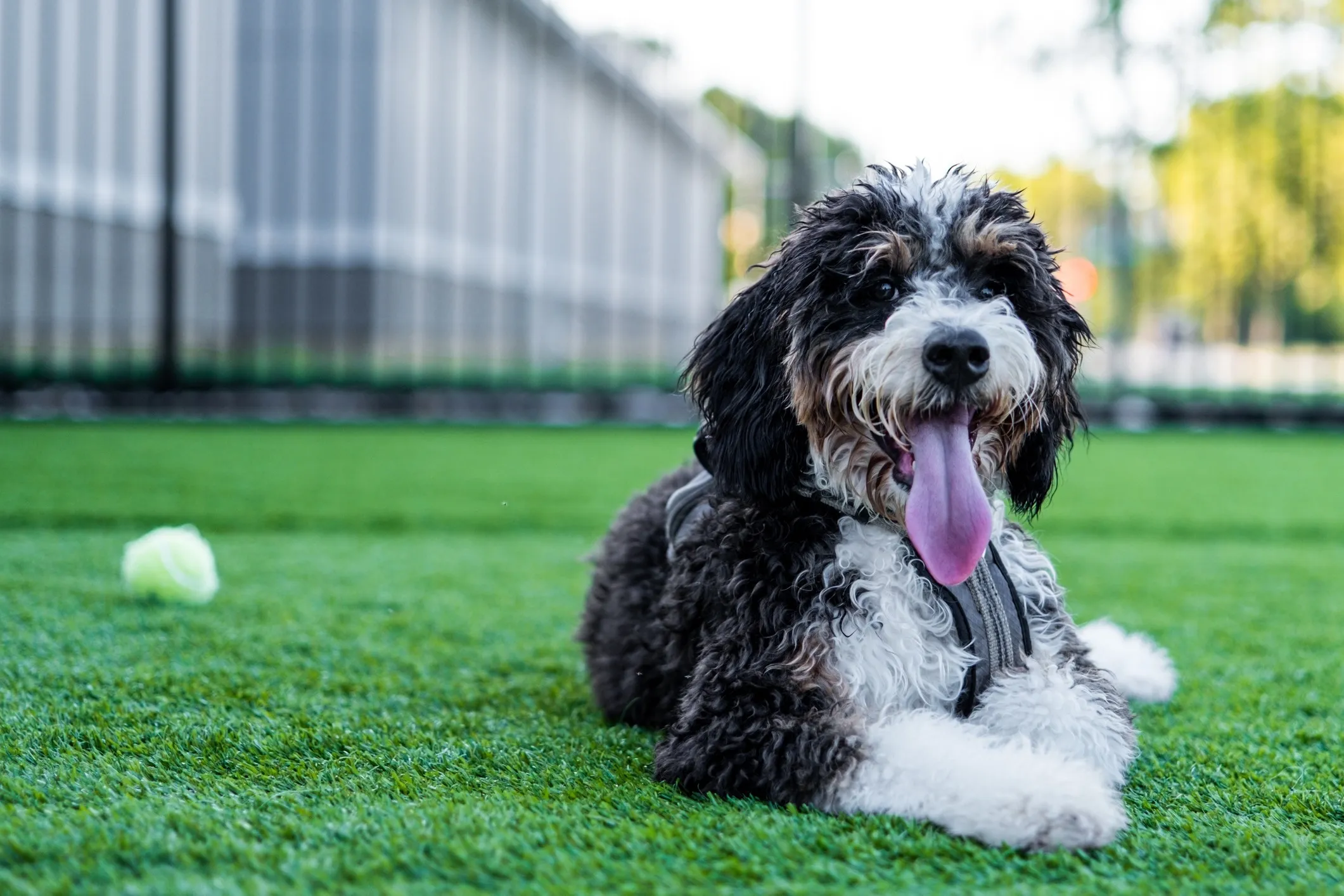 Large Bernedoodle dog happily lying in green grass with its tongue out
Large Bernedoodle dog happily lying in green grass with its tongue out
Bernedoodles are a charming crossbreed between the loyal Bernese Mountain Dog and the intelligent Poodle. These large, affectionate dogs combine the gentle demeanor of the Bernese with the low-shedding coat of the Poodle, making them a popular choice for families with children and other pets, even those with allergies. Their friendly and patient nature, coupled with their minimal shedding, positions them as good family dogs that don’t shed much. Bernedoodles require plenty of exercise to stay active and happy, and their wavy or curly coats need regular grooming to prevent matting.
25. Shorkie
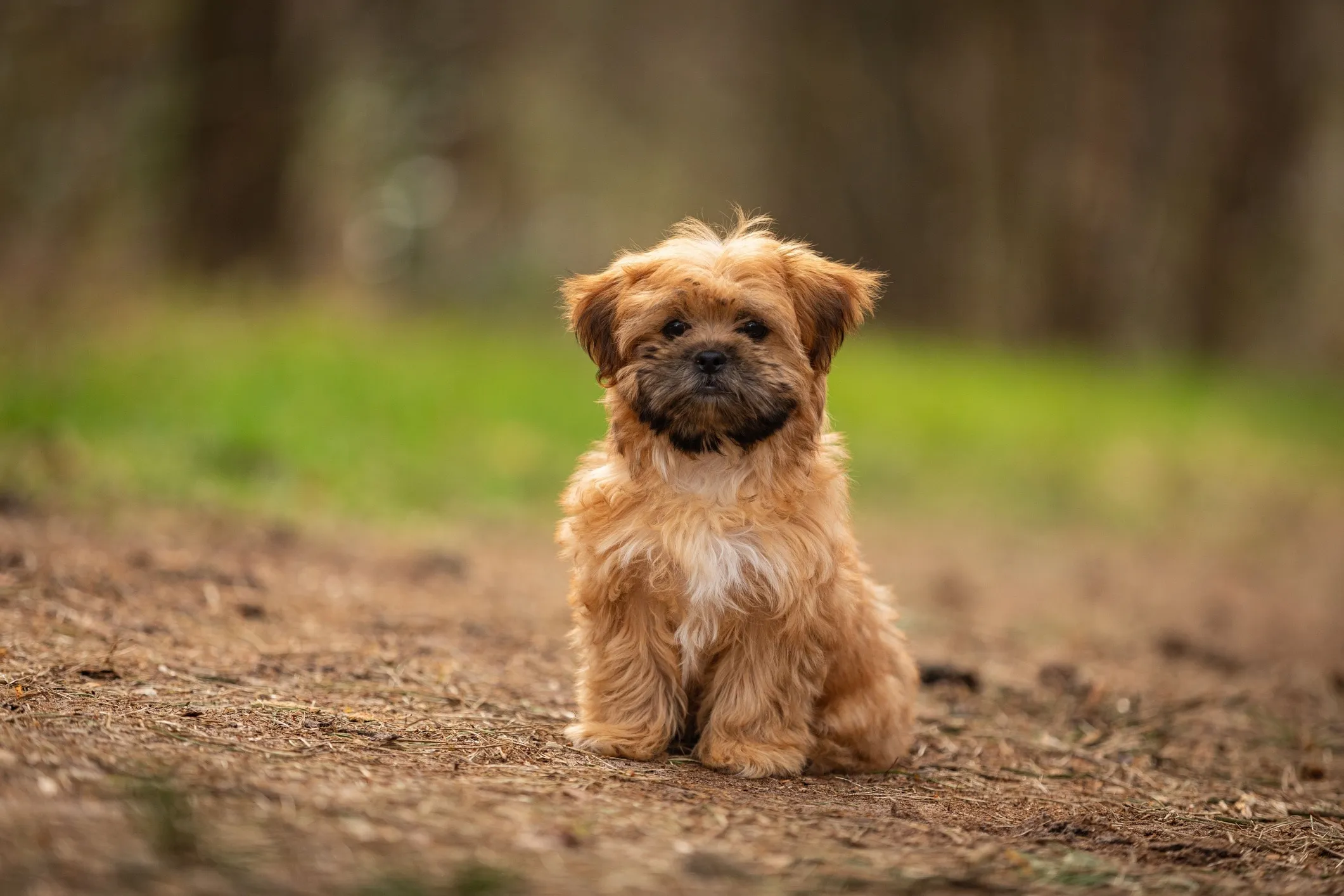 Adorable tan and black Shih Tzu and Yorkie mix (Shorkie) sitting on a hiking trail
Adorable tan and black Shih Tzu and Yorkie mix (Shorkie) sitting on a hiking trail
The Shorkie is a mixed breed resulting from a cross between two low-shedding breeds: the Shih Tzu and the Yorkshire Terrier. This delightful combination yields a small, playful, and friendly companion that embodies the best traits of both parents. Shorkies are typically adaptable and thrive on close companionship. Like most low-shedding dogs, they require a regular grooming routine, including daily brushing to maintain their fine, hair-like coat and prevent tangles. Their compact size and charming personality make them an excellent choice for a small lap dog that doesn’t shed.
26. Afghan Hound
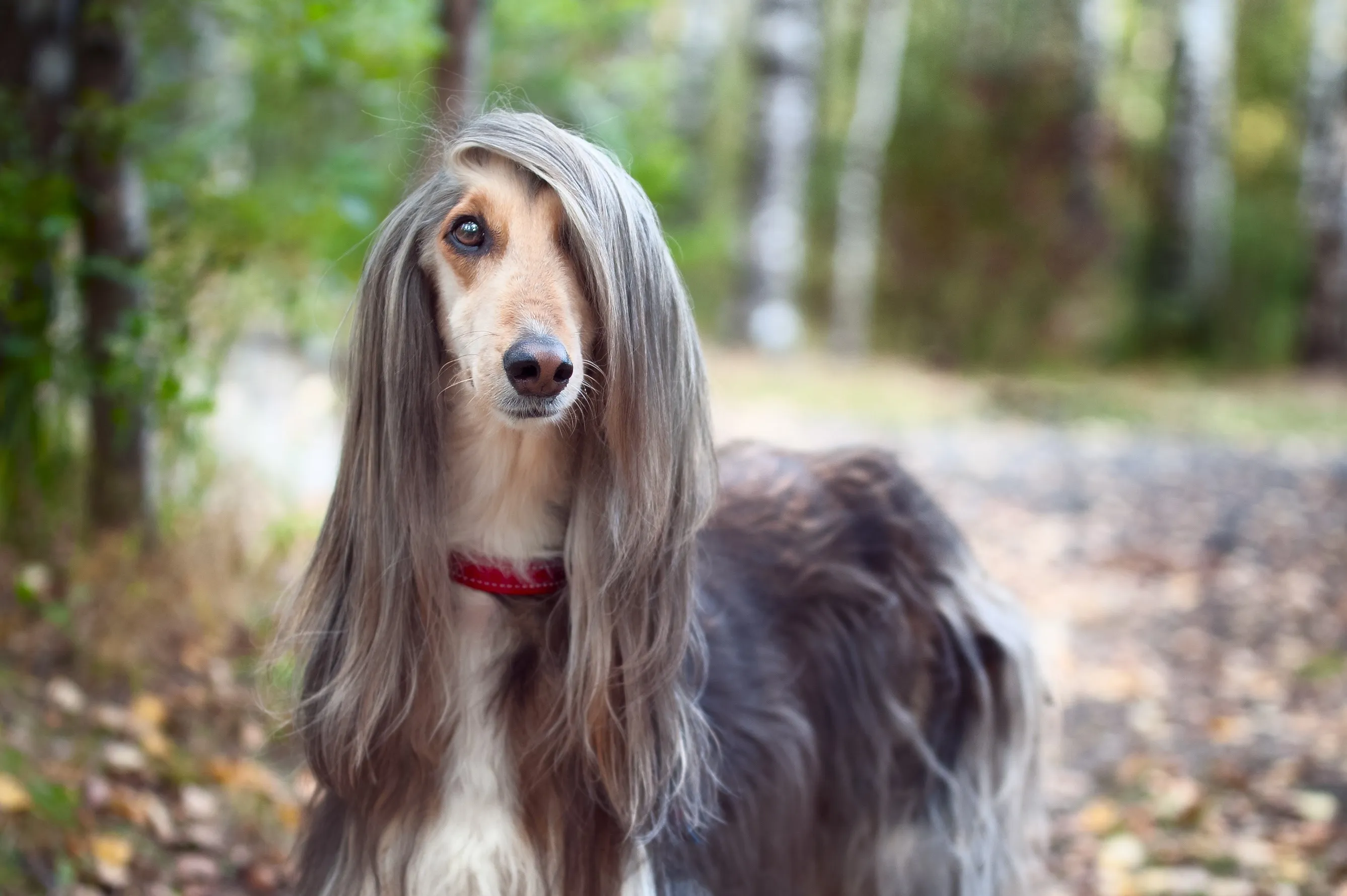 Elegant gray and tan Afghan Hound with long, flowing hair looking at the camera
Elegant gray and tan Afghan Hound with long, flowing hair looking at the camera
Afghan Hounds are striking dogs, instantly recognizable by their long, flowing, silky coats and slender, elegant builds. Despite their voluminous hair, they are considered low-shedding compared to many other breeds. These majestic pups are built for speed and endurance, known as one of the fastest dog breeds in the world. While loving and devoted to their families, Afghan Hounds can be aloof and independent, requiring consistent early socialization to ensure they are well-adjusted around strangers. Their high-maintenance coat requires daily brushing and frequent professional grooming to prevent matting and keep it pristine.
27. Barbet
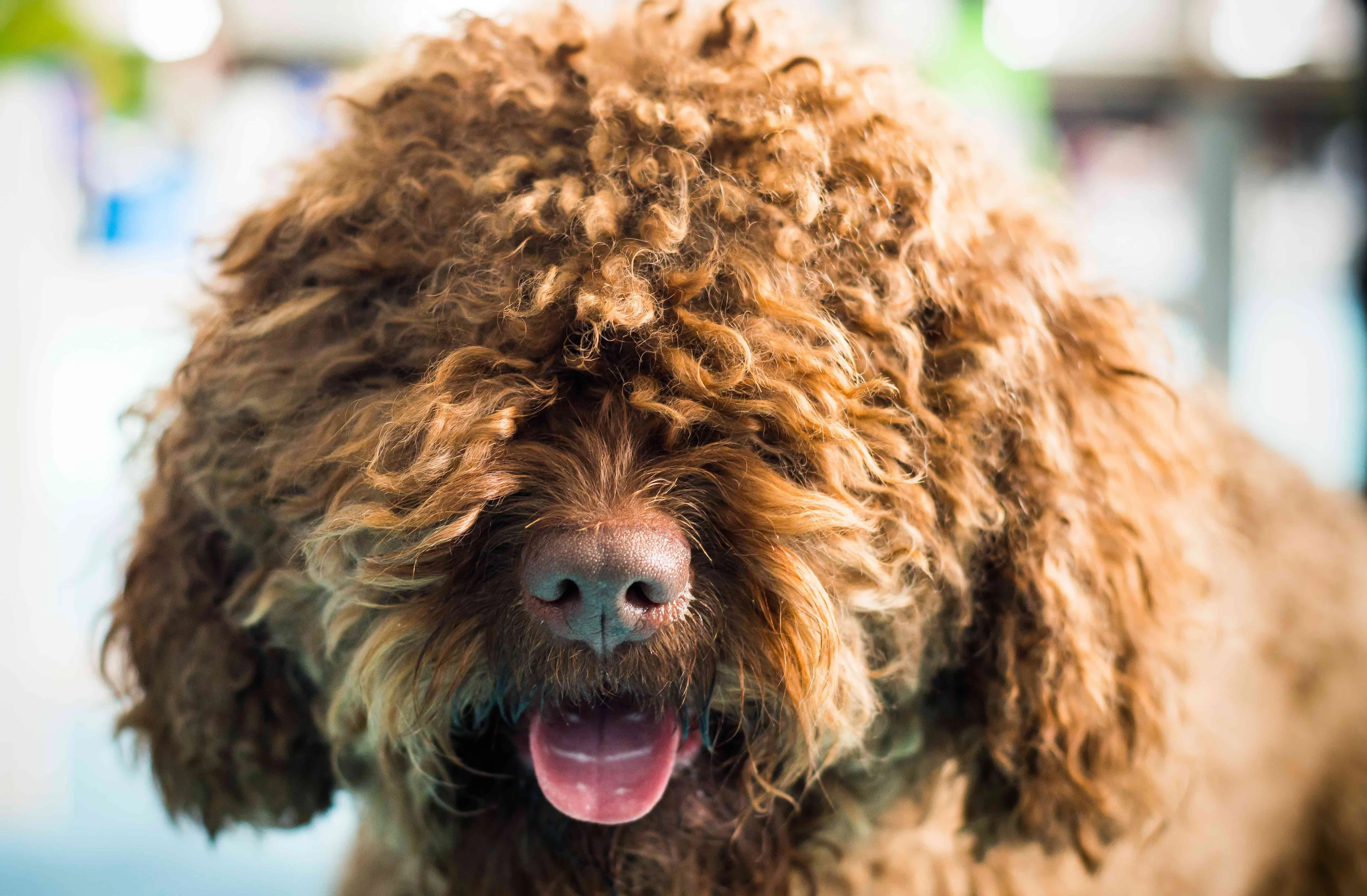 Close-up of a cheerful curly red Barbet dog face with a distinctive beard
Close-up of a cheerful curly red Barbet dog face with a distinctive beard
The Barbet, pronounced “bar-bay,” is a cheerful and shaggy water dog from France. Its name, derived from the French word barbe (beard), aptly describes its characteristically hairy chin. This big, hypoallergenic dog possesses a dense, woolly, curly coat that sheds minimally and provides excellent insulation in cold water. Barbets love to swim and are active, intelligent companions. To maintain their protective coat in good condition, especially after water activities, regular brushing with a slicker or pin brush two to three times a week is essential to prevent matting and ensure skin health. The Barbet is a robust and lively companion for active families.
28. Shih-Poo
 Close-up of an adorable tan and black Shih-Poo dog
Close-up of an adorable tan and black Shih-Poo dog
The Shih-Poo is a mixed breed resulting from a cross between a Shih Tzu and a Poodle, most commonly a Toy Poodle. This small, charming pup inherits the low-shedding qualities of both parent breeds. Shih-Poos are adaptable and can thrive in almost any living situation, whether an apartment or a larger house, as long as they receive about 30 minutes of daily exercise and consistent grooming. Their playful and affectionate nature makes them delightful companions, but their soft, wavy or curly coat requires daily brushing to prevent tangles and maintain its health.
29. Peruvian Inca Orchid
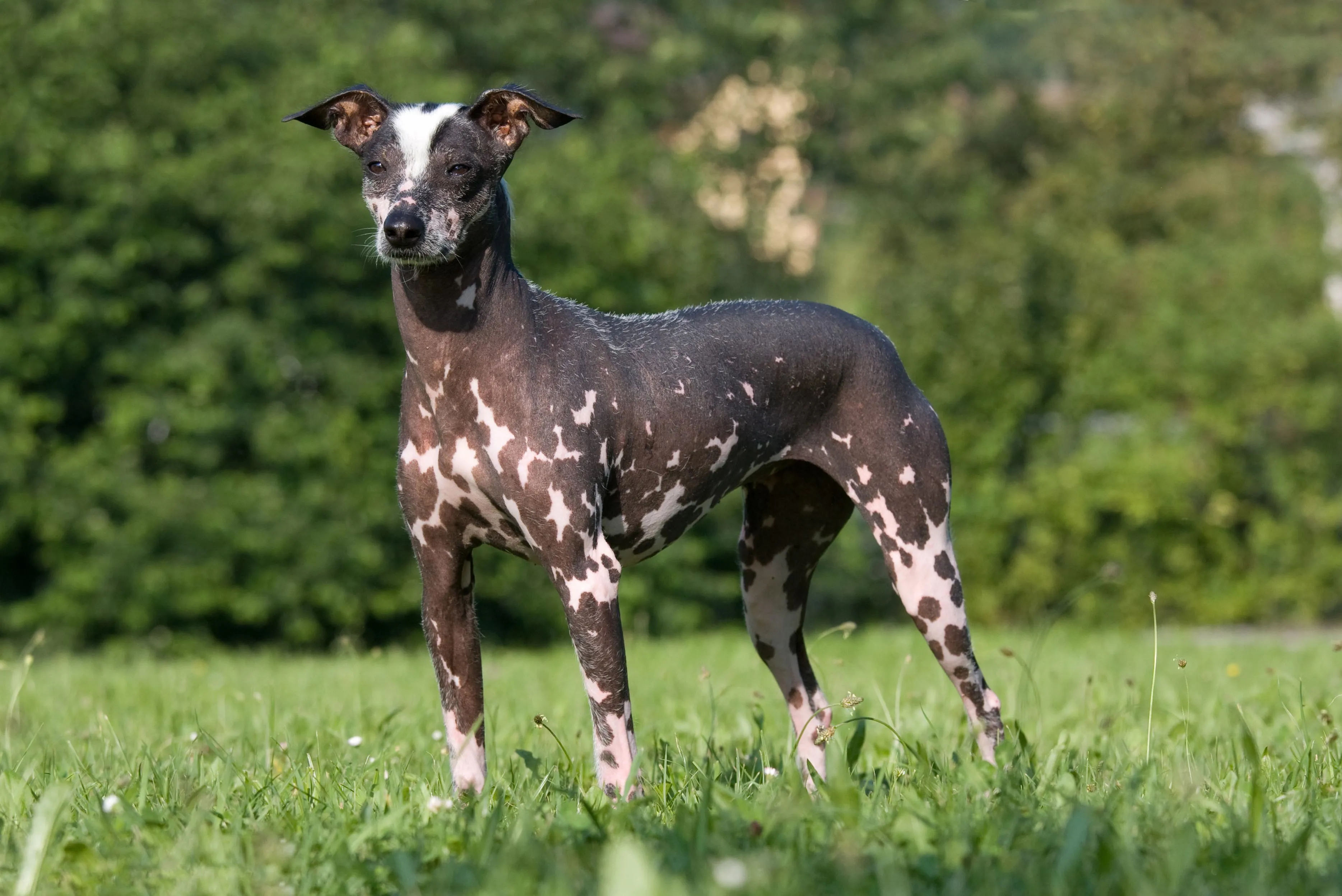 Graceful Peruvian Inca Orchid dog
Graceful Peruvian Inca Orchid dog
The Peruvian Inca Orchid is a rare and ancient dog breed, recognized as the national dog of Peru. They are considered hypoallergenic due to their nearly hairless bodies, though some do have a short coat. This breed comes in three sizes: small, medium, and large. Peruvian Inca Orchids are elegant, agile, and intelligent dogs, known for being loyal and protective of their families. The hairless variety requires special attention to skin care, including moisturizing and sun protection, while the coated variety needs minimal grooming.
30. Malshi
 Happy tricolor Malshi dog sitting playfully in vibrant green grass
Happy tricolor Malshi dog sitting playfully in vibrant green grass
The Malshi is a joyful and small low-shedding dog, a cross between the Maltese and the Shih Tzu. These charming mixed-breed dogs thrive on close companionship and are happiest when their favorite humans are near. Malshis are affectionate, playful, and generally adapt well to various home environments. Their fluffy, hair-like coat, inherited from both parent breeds, sheds minimally but requires consistent daily brushing and regular professional grooming to prevent matting and keep them looking their best. They are delightful companions for those seeking a small lap dog that doesn’t shed.
Living Successfully with a Low-Shedding Dog
While these breeds shed minimally, living with a low-shedding dog still requires proactive measures to manage potential allergens and ensure a healthy environment for both you and your pet.
Commitment to Regular Grooming
Even dog breeds that don’t shed profusely still require regular grooming. Their coats, which often grow continuously, can trap dander and dirt, and without proper care, can become matted, leading to skin issues.
- Brushing: Daily or every-other-day brushing is crucial for most low-shedding breeds to remove loose hairs and dander trapped in their coats. This significantly reduces the amount of allergens released into your home.
- Bathing: Regular bathing, typically every four to six weeks, helps to wash away dander, saliva residue, and other allergens from your dog’s coat. Using a gentle, veterinarian-recommended shampoo can further minimize skin irritation and dander production. Products specifically designed to reduce pet dander can also be beneficial.
- Professional Grooming: Many low-shedding breeds require regular trimming, clipping, or hand-stripping by a professional groomer every 4-8 weeks to maintain their coat’s health and appearance. Budget for these ongoing costs or learn proper techniques for at-home grooming.
Maintaining a Clean Home Environment
Minimizing allergens in your home goes beyond just grooming your dog. A clean living space is essential for managing dog allergies.
- Vacuuming and Dusting: Regularly vacuum carpets, rugs, and upholstery with a HEPA filter vacuum cleaner. Dust surfaces frequently with a damp cloth to trap allergens.
- Washing Bedding: Wash your dog’s bedding and your own bedding regularly in hot water to remove dander.
- Air Purification: Using high-efficiency particulate air (HEPA) purifiers can help filter airborne allergens, improving air quality in your home.
- Ventilation: Keep your home well-ventilated, especially in areas where your dog spends a lot of time.
- Designated Dog-Free Zones: Consider designating certain areas of your home, such as bedrooms, as dog-free zones to create allergen-reduced spaces for allergy sufferers.
Consulting Healthcare Professionals
Managing allergies effectively is a collaborative effort between pet parents and healthcare providers.
- Allergist Consultation: If you or a family member suffer from allergies, consult an allergist. They can provide an accurate diagnosis, recommend specific treatments such as antihistamines, nasal sprays, or allergy injections (immunotherapy), and offer personalized advice on managing your symptoms while living with a dog.
- Veterinarian Check-ups: Regular veterinary check-ups are important to ensure your dog’s skin and coat health, as healthy skin produces less dander. Your vet can also advise on appropriate grooming products and routines.
- Avoid Contact with Saliva and Urine: While low-shedding dogs reduce dander, allergens are still present in their saliva and urine. Avoid close contact with these bodily fluids, and wash hands thoroughly after playing with your dog.
Conclusion
Choosing one of the most popular dog breeds that don’t shed is a fantastic way for individuals and families with allergies to welcome a canine companion into their lives. While no dog is truly hypoallergenic, these breeds offer a significantly lower allergen burden, making the joys of pet ownership accessible to more people. By understanding the nuances of low shedding, committing to consistent grooming, maintaining a clean home environment, and consulting with healthcare professionals, you can create a harmonious and comfortable home for everyone. The unwavering loyalty and boundless affection of a dog are invaluable, and with these breeds, allergy sufferers can fully experience that profound connection.
References
- National Institute of Environmental Health Sciences. (n.d.). Pets and Allergens. Retrieved from https://www.niehs.nih.gov/health/topics/agents/allergens/pets/index.cfm
- American Kennel Club (AKC). (n.d.). Breed Information. Retrieved from https://www.akc.org/dog-breeds/
- The Humane Society of the United States. (n.d.). Allergies to Pets. Retrieved from https://www.humanesociety.org/resources/allergies-pets
